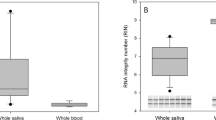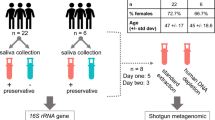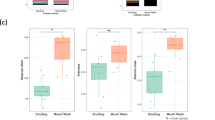Abstract
Objective:
To evaluate two saliva collection methods for DNA yield and quality as applied to a large, integrated, multicentre, European project involving the collection of biological material from children.
Design:
Cross-sectional multicentre comparative study in young children.
Methods:
Saliva samples were collected from 14 019 children aged 2–9 years from eight European countries participating in the IDEFICS (Identification and prevention of dietary- and lifestyle-induced health effects in children and infants) study. This involved either the collection of 2 ml of saliva from children who were able to spit, or using a sponge to collect whole saliva and buccal mucosal cells from the inside of the mouth of younger children unable to spit. Samples were assembled centrally in each participating centre and subsequently despatched for DNA extraction and biobanking to the University of Glasgow. A subgroup of 4678 samples (∼33% of sampled individuals) were chosen for DNA extraction before genotyping.
Results:
The whole-saliva collection method resulted in a higher DNA yield than the sponge collection method (mean±s.d.; saliva: 20.95±2.35 μg, sponge: 9.13±2.25 μg; P<0.001). DNA quality as measured by A260/A280 was similar for the two collection methods. A minimum genotype calling success rate of 95% showed that both methods provide good-quality DNA for genotyping using TaqMan allelic discrimination assays.
Conclusions:
Our results showed higher DNA yield from the whole-saliva collection method compared with the assisted sponge collection. However, both collection methods provided DNA of sufficient quantity and quality for large-scale genetic epidemiological studies.
This is a preview of subscription content, access via your institution
Access options
Subscribe to this journal
Receive 12 print issues and online access
$259.00 per year
only $21.58 per issue
Buy this article
- Purchase on Springer Link
- Instant access to full article PDF
Prices may be subject to local taxes which are calculated during checkout

Similar content being viewed by others
References
Nishita DM, Jack LM, McElroy M, McClure JB, Richards J, Swan GE et al. Clinical trial participant characteristics and saliva and DNA metrics. BMC Med Res Methodol 2009; 9: 71.
Rylander-Rudqvist T, Hakansson N, Tybring G, Wolk A . Quality and quantity of saliva DNA obtained from the self-administrated oragene method—a pilot study on the cohort of Swedish men. Cancer Epidemiol Biomarkers Prev 2006; 15: 1742–1745.
Philibert RA, Zadorozhnyaya O, Beach SR, Brody GH . Comparison of the genotyping results using DNA obtained from blood and saliva. Psychiatr Genet 2008; 18: 275–281.
Matheson LA, Duong TT, Rosenberg AM, Yeung RS . Assessment of sample collection and storage methods for multicenter immunologic research in children. J Immunol Methods 2008; 339: 82–89.
Streckfus CF, Bigler LR . Saliva as a diagnostic fluid. Oral Dis 2002; 8: 69–76.
Ng DP, Koh D, Choo S, Chia KS . Saliva as a viable alternative source of human genomic DNA in genetic epidemiology. Clin Chim Acta 2006; 367: 81–85.
McMichael GL, Gibson CS, O’Callaghan ME, Goldwater PN, Dekker GA, Haan EA et al. DNA from buccal swabs suitable for high-throughput SNP multiplex analysis. J Biomol Tech 2009; 20: 232–235.
Ahrens W, Bammann K, de Henauw S, Halford J, Palou A, Pigeot I et al. Understanding and preventing childhood obesity and related disorders—IDEFICS: a European multilevel epidemiological approach. Nutr Metab Cardiovasc Dis 2006; 16: 302–308.
Haerens L, De Bourdeaudhuij I, Eiben G, Lauria F, Bel S, Keimer K et al. Formative research to develop the IDEFICS physical activity intervention component: findings from focus groups with children and parents. J Phys Act Health 2010; 7: 246–256.
Espana-Romero V, Artero EG, Santaliestra-Pasias AM, Gutierrez A, Castillo MJ, Ruiz JR . Hand span influences optimal grip span in boys and girls aged 6–12 years. J Hand Surg Am 2008; 33: 378–384.
Bammann K, Peplies J, Sjostrom M, Lissner L, De Henauw S, Galli C et al. Assessment of diet, physical activity and biological, social and environmental factors in a multi-centre European project on diet- and lifestyle-related disorders in children (IDEFICS). J Public Health 2006; 15: 279–289.
Pigeot I, Barba G, Chadjigeorgiou C, de Henauw S, Kourides Y, Lissner L et al. Prevalence and determinants of childhood overweight and obesity in European countries: pooled analysis of the existing surveys within the IDEFICS Consortium. Int J Obes (Lond) 2009; 33: 1103–1110.
Ahrens W, Bammann K, Siani A, Buchecker K, De Henauw S, Iacoviello L et al. The IDEFICS cohort: design, characteristics and participation in the baseline survey. Int J Obes 2011; 35 (Suppl 1): S3–S15.
Garcia-Closas M, Egan KM, Abruzzo J, Newcomb PA, Titus-Ernstoff L, Franklin T et al. Collection of genomic DNA from adults in epidemiological studies by buccal cytobrush and mouthwash. Cancer Epidemiol Biomarkers Prev 2001; 10: 687–696.
Feigelson HS, Rodriguez C, Robertson AS, Jacobs EJ, Calle EE, Reid YA et al. Determinants of DNA yield and quality from buccal cell samples collected with mouthwash. Cancer Epidemiol Biomarkers Prev 2001; 10: 1005–1008.
King IB, Satia-Abouta J, Thornquist MD, Bigler J, Patterson RE, Kristal AR et al. Buccal cell DNA yield, quality, and collection costs: comparison of methods for large-scale studies. Cancer Epidemiol Biomarkers Prev 2002; 11: 1130–1133.
Quinque D, Kittler R, Kayser M, Stoneking M, Nasidze I . Evaluation of saliva as a source of human DNA for population and association studies. Anal Biochem 2006; 353: 272–277.
Hansen TV, Simonsen MK, Nielsen FC, Hundrup YA . Collection of blood, saliva, and buccal cell samples in a pilot study on the Danish nurse cohort: comparison of the response rate and quality of genomic DNA. Cancer Epidemiol Biomarkers Prev 2007; 16: 2072–2076.
Rogers NL, Cole SA, Lan HC, Crossa A, Demerath EW . New saliva DNA collection method compared to buccal cell collection techniques for epidemiological studies. Am J Hum Biol 2007; 19: 319–326.
Maximizing DNA yield with Oragene® DNA. http://www.dnagenotek.com.
Peplies J, Fraterman A, Scott R, Russo P, Bammann K . Quality management for the collection of biological samples in multicentre studies. Eur J Epidemiol 2010; 25: 607–617.
Acknowledgements
We acknowledge all members of the UGLW DNA extraction team for their excellent technical assistance in completing the DNA extraction process. This study was conducted as part of the IDEFICS study (http://www.idefics.eu). We gratefully acknowledge the financial support of the European Community within the Sixth RTD Framework Programme Contract No. 016181 (FOOD).
The information in this document reflects the author's view and is provided as is.
Author information
Authors and Affiliations
Consortia
Corresponding author
Ethics declarations
Competing interests
The authors declare no conflict of interest.
Additional information
Statement of ethics
We certify that all applicable institutional and governmental regulations pertaining to the ethical use of human volunteers were followed during this research. Approval by the appropriate ethics committees was obtained by each of the eight centres carrying out the fieldwork. Participants were not subjected to any study procedure before both the children and their parents gave consent for examinations, collection of samples, subsequent analysis and storage of personal data and collected samples. The participating children and their parents could consent to single components of the study while refraining from others.
Rights and permissions
About this article
Cite this article
Koni, A., Scott, R., Wang, G. et al. DNA yield and quality of saliva samples and suitability for large-scale epidemiological studies in children. Int J Obes 35 (Suppl 1), S113–S118 (2011). https://doi.org/10.1038/ijo.2011.43
Published:
Issue Date:
DOI: https://doi.org/10.1038/ijo.2011.43
Keywords
This article is cited by
-
The study of women, infant feeding and type 2 diabetes after GDM pregnancy and growth of their offspring (SWIFT Offspring study): prospective design, methodology and baseline characteristics
BMC Pregnancy and Childbirth (2015)
-
Challenges in Studying Modifiable Risk Factors for Birth Defects
Current Epidemiology Reports (2015)
-
Simple Sequence Repeats in the National Longitudinal Study of Adolescent Health: An Ethnically Diverse Resource for Genetic Analysis of Health and Behavior
Behavior Genetics (2014)
-
Polymorphisms of matrix metalloproteinase gene and adiposity indices in European children: results of the IDEFICS study
International Journal of Obesity (2013)
-
Rapid extraction and preservation of genomic DNA from human samples
Analytical and Bioanalytical Chemistry (2013)



